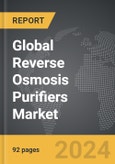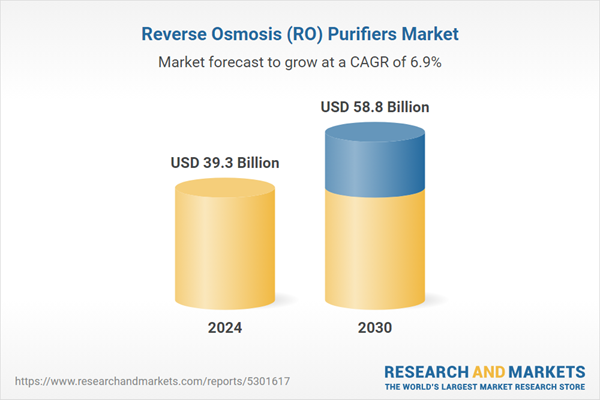The global market for Reverse Osmosis (RO) Purifiers was valued at US$39.3 Billion in 2024 and is projected to reach US$58.8 Billion by 2030, growing at a CAGR of 6.9% from 2024 to 2030. This comprehensive report provides an in-depth analysis of market trends, drivers, and forecasts, helping you make informed business decisions. The report includes the most recent global tariff developments and how they impact the Reverse Osmosis (RO) Purifiers market.
Segments: End-Use (Residential, Commercial, Industrial).
Geographic Regions/Countries: World; United States; Canada; Japan; China; Europe (France; Germany; Italy; United Kingdom; Spain; Russia; and Rest of Europe); Asia-Pacific (Australia; India; South Korea; and Rest of Asia-Pacific); Latin America (Argentina; Brazil; Mexico; and Rest of Latin America); Middle East (Iran; Israel; Saudi Arabia; United Arab Emirates; and Rest of Middle East); and Africa.
The analysts continuously track trade developments worldwide, drawing insights from leading global economists and over 200 industry and policy institutions, including think tanks, trade organizations, and national economic advisory bodies. This intelligence is integrated into forecasting models to provide timely, data-driven analysis of emerging risks and opportunities.
Global Reverse Osmosis (RO) Purifiers Market - Key Trends and Drivers Summarized
What Are Reverse Osmosis Purifiers and How Do They Work?
Reverse Osmosis (RO) purifiers are water filtration systems that use a semi-permeable membrane to remove contaminants, particles, and impurities from water. The process of reverse osmosis involves forcing water through this membrane under high pressure, allowing only water molecules to pass through while blocking larger molecules such as salts, bacteria, viruses, and other contaminants. The membrane's microscopic pores are designed to filter out substances as small as 0.0001 microns, making RO one of the most effective purification methods available. Typically, an RO system consists of several stages, including pre-filters (to remove sediment and chlorine), the RO membrane, and post-filters (to polish the water by removing any residual taste or odor). This multi-stage filtration ensures that the water is free from harmful chemicals, heavy metals, microorganisms, and dissolved solids, delivering clean, safe drinking water. RO purifiers are widely used in residential, commercial, and industrial applications to provide high-quality water where contamination is a concern. With increasing concerns about water quality worldwide, these purifiers have become a critical tool in ensuring safe and healthy drinking water for millions of people.Why Are Reverse Osmosis Purifiers Important for Water Quality and Health?
RO purifiers play a critical role in improving water quality, particularly in regions where the water supply is contaminated with chemicals, heavy metals, or high levels of dissolved solids. For households, RO systems provide peace of mind by ensuring that the water consumed is free from harmful contaminants such as lead, arsenic, mercury, and nitrates, which are common in some municipal water supplies and well water systems. These contaminants can have long-term health effects, including neurological damage, cardiovascular diseases, and other chronic conditions, especially when ingested over time. By removing these harmful substances, RO purifiers help protect families from waterborne illnesses and ensure that drinking water meets or exceeds safety standards. In addition to health benefits, RO purifiers are also essential in addressing taste and odor issues in water. Municipal water systems often treat water with chlorine and other chemicals to eliminate pathogens, but these chemicals can leave an unpleasant taste and smell in the water. RO systems effectively remove these chemical additives, delivering clean, fresh-tasting water that is more enjoyable to drink. This makes RO purifiers particularly important for people who are sensitive to the taste of tap water or who live in areas with poor water quality. Moreover, RO systems are increasingly being used in commercial and industrial settings, such as food and beverage production, pharmaceuticals, and electronics manufacturing, where ultra-pure water is essential for ensuring product quality and safety.How Are RO Purifiers Evolving with Technological Advancements?
With the increasing demand for clean water and growing environmental concerns, RO purifiers are incorporating new technologies to enhance efficiency, reduce waste, and provide more sustainable solutions. One of the most significant advancements in RO technology is the improvement in membrane design and material. Modern RO membranes are more durable and efficient, capable of filtering water at higher pressures and reducing the overall amount of water wasted during the filtration process. Traditional RO systems are often criticized for their high water waste, with older models typically wasting up to three to four gallons of water for every gallon of purified water produced. However, newer models feature advanced water-saving technologies, such as low-rejection rate membranes and permeate pumps, which can reduce water wastage to less than one gallon per gallon of clean water produced. Another notable technological advancement is the integration of smart sensors and monitoring systems. Many RO purifiers now come equipped with digital displays and real-time monitoring features that provide users with important information about their water quality, system performance, and filter life. These smart systems not only offer convenience but also improve the overall maintenance and efficiency of the RO unit by alerting users when filters need to be replaced or when system faults occur. Additionally, innovations in tankless RO systems have emerged, offering more compact designs that eliminate the need for traditional water storage tanks, making these systems easier to install in homes with limited space. Furthermore, as sustainability becomes a key consideration for consumers, RO manufacturers are focusing on creating energy-efficient and eco-friendly models.What Are the Key Growth Drivers of the Reverse Osmosis Purifier Market?
The growth of the reverse osmosis purifier market is driven by several key factors, including increasing water contamination concerns, rising consumer awareness of waterborne health risks, and technological advancements that have improved the efficiency and affordability of RO systems. One of the main drivers is the growing global awareness of the health risks associated with contaminated drinking water. In both developed and developing countries, concerns over water quality have escalated due to reports of industrial pollution, agricultural runoff, and aging municipal water infrastructure, all of which can introduce harmful chemicals and pathogens into the water supply. As consumers become more conscious of these risks, the demand for reliable water purification systems, particularly RO purifiers, has increased. Additionally, government regulations and initiatives promoting clean drinking water are pushing the adoption of RO systems in both residential and commercial settings. In many countries, authorities are implementing stricter water quality standards and encouraging households and businesses to adopt advanced water filtration solutions to meet these requirements. Technological advancements have also played a major role in the market's growth by making RO systems more affordable, efficient, and user-friendly. Innovations in membrane technology, smart sensors, and water-saving features have addressed previous concerns about water waste and system complexity, making RO purifiers more attractive to a wider consumer base. Moreover, as sustainability becomes a major consumer priority, the development of eco-friendly RO systems that minimize water waste and energy consumption is appealing to environmentally conscious buyers. The rise of e-commerce and global distribution networks has made it easier for consumers to access a wide variety of RO systems. Lastly, the increasing demand for clean water in industrial applications where ultrapure water is essential is another major growth driver. These combined factors are fueling robust growth in the Reverse Osmosis purifier market as consumers and industries alike seek effective, sustainable solutions for ensuring clean, safe water.Report Scope
The report analyzes the Reverse Osmosis (RO) Purifiers market, presented in terms of units. The analysis covers the key segments and geographic regions outlined below.Segments: End-Use (Residential, Commercial, Industrial).
Geographic Regions/Countries: World; United States; Canada; Japan; China; Europe (France; Germany; Italy; United Kingdom; Spain; Russia; and Rest of Europe); Asia-Pacific (Australia; India; South Korea; and Rest of Asia-Pacific); Latin America (Argentina; Brazil; Mexico; and Rest of Latin America); Middle East (Iran; Israel; Saudi Arabia; United Arab Emirates; and Rest of Middle East); and Africa.
Key Insights:
- Market Growth: Understand the significant growth trajectory of the Residential segment, which is expected to reach US$35.4 Billion by 2030 with a CAGR of a 7.5%. The Commercial segment is also set to grow at 6.5% CAGR over the analysis period.
- Regional Analysis: Gain insights into the U.S. market, valued at $10.2 Billion in 2024, and China, forecasted to grow at an impressive 10.1% CAGR to reach $13.8 Billion by 2030. Discover growth trends in other key regions, including Japan, Canada, Germany, and the Asia-Pacific.
Why You Should Buy This Report:
- Detailed Market Analysis: Access a thorough analysis of the Global Reverse Osmosis (RO) Purifiers Market, covering all major geographic regions and market segments.
- Competitive Insights: Get an overview of the competitive landscape, including the market presence of major players across different geographies.
- Future Trends and Drivers: Understand the key trends and drivers shaping the future of the Global Reverse Osmosis (RO) Purifiers Market.
- Actionable Insights: Benefit from actionable insights that can help you identify new revenue opportunities and make strategic business decisions.
Key Questions Answered:
- How is the Global Reverse Osmosis (RO) Purifiers Market expected to evolve by 2030?
- What are the main drivers and restraints affecting the market?
- Which market segments will grow the most over the forecast period?
- How will market shares for different regions and segments change by 2030?
- Who are the leading players in the market, and what are their prospects?
Report Features:
- Comprehensive Market Data: Independent analysis of annual sales and market forecasts in US$ Million from 2024 to 2030.
- In-Depth Regional Analysis: Detailed insights into key markets, including the U.S., China, Japan, Canada, Europe, Asia-Pacific, Latin America, Middle East, and Africa.
- Company Profiles: Coverage of players such as A. O. Smith Corporation, Blue Star Limited, Eureka Forbes, KENT RO Systems Ltd., Livpure Pvt. Ltd. and more.
- Complimentary Updates: Receive free report updates for one year to keep you informed of the latest market developments.
Some of the 36 companies featured in this Reverse Osmosis (RO) Purifiers market report include:
- A. O. Smith Corporation
- Blue Star Limited
- Eureka Forbes
- KENT RO Systems Ltd.
- Livpure Pvt. Ltd.
Tariff Impact Analysis: Key Insights for 2025
Global tariff negotiations across 180+ countries are reshaping supply chains, costs, and competitiveness. This report reflects the latest developments as of April 2025 and incorporates forward-looking insights into the market outlook.The analysts continuously track trade developments worldwide, drawing insights from leading global economists and over 200 industry and policy institutions, including think tanks, trade organizations, and national economic advisory bodies. This intelligence is integrated into forecasting models to provide timely, data-driven analysis of emerging risks and opportunities.
What’s Included in This Edition:
- Tariff-adjusted market forecasts by region and segment
- Analysis of cost and supply chain implications by sourcing and trade exposure
- Strategic insights into geographic shifts
Buyers receive a free July 2025 update with:
- Finalized tariff impacts and new trade agreement effects
- Updated projections reflecting global sourcing and cost shifts
- Expanded country-specific coverage across the industry
Table of Contents
I. METHODOLOGYII. EXECUTIVE SUMMARY2. FOCUS ON SELECT PLAYERSIII. MARKET ANALYSISIV. COMPETITION
1. MARKET OVERVIEW
3. MARKET TRENDS & DRIVERS
4. GLOBAL MARKET PERSPECTIVE
UNITED STATES
CANADA
JAPAN
CHINA
EUROPE
FRANCE
GERMANY
ITALY
UNITED KINGDOM
SPAIN
RUSSIA
REST OF EUROPE
ASIA-PACIFIC
AUSTRALIA
INDIA
SOUTH KOREA
REST OF ASIA-PACIFIC
LATIN AMERICA
ARGENTINA
BRAZIL
MEXICO
REST OF LATIN AMERICA
MIDDLE EAST
IRAN
ISRAEL
SAUDI ARABIA
UNITED ARAB EMIRATES
REST OF MIDDLE EAST
AFRICA
Companies Mentioned (Partial List)
A selection of companies mentioned in this report includes, but is not limited to:
- A. O. Smith Corporation
- Blue Star Limited
- Eureka Forbes
- KENT RO Systems Ltd.
- Livpure Pvt. Ltd.
Table Information
| Report Attribute | Details |
|---|---|
| No. of Pages | 92 |
| Published | April 2025 |
| Forecast Period | 2024 - 2030 |
| Estimated Market Value ( USD | $ 39.3 Billion |
| Forecasted Market Value ( USD | $ 58.8 Billion |
| Compound Annual Growth Rate | 6.9% |
| Regions Covered | Global |









